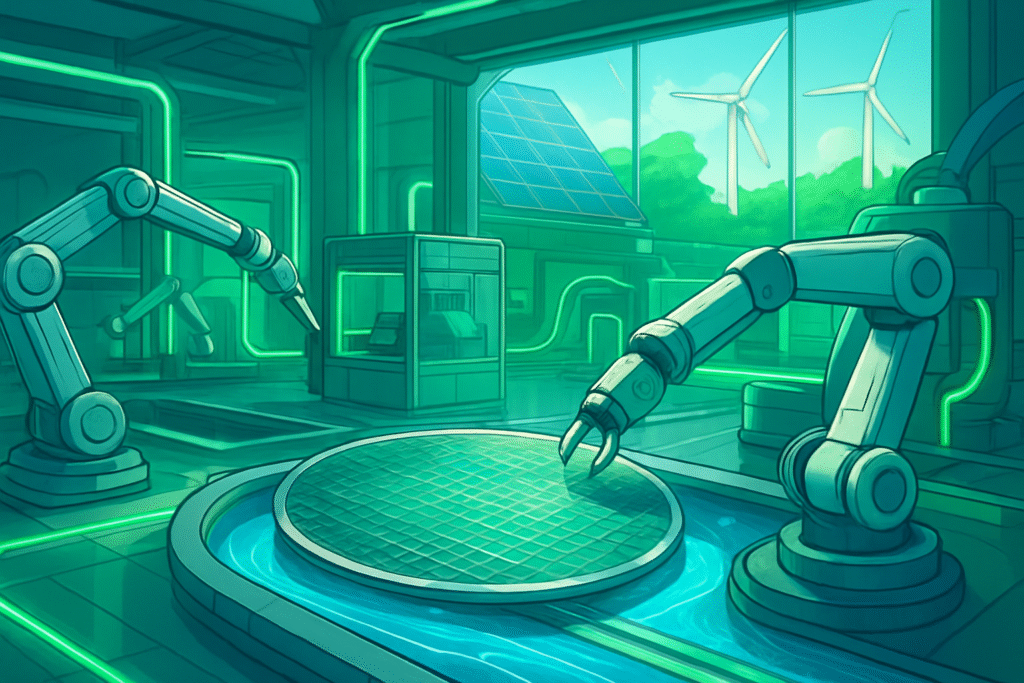
The relentless march of Artificial Intelligence (AI) is ushering in an era of unprecedented technological advancement, yet it casts a long shadow over our planet. The production of the vast number of specialized chips required to power this AI revolution, alongside the immense energy demands of AI data centers, is creating an environmental burden that can no longer be ignored. From soaring energy consumption and prodigious water usage to the escalating problem of electronic waste, the sustainability of semiconductor manufacturing for AI has become a critical and immediate concern for the tech industry and global environmental advocates alike.
As AI models grow in complexity and ubiquity, the environmental footprint of their underlying hardware is expanding at an alarming rate. This urgent challenge compels the semiconductor industry to rapidly pivot towards greener practices, integrating sustainability into every facet of chip design, fabrication, and deployment. The stakes are high: failure to address these environmental impacts could undermine global climate goals and strain vital natural resources, making the pursuit of sustainable AI not just an ethical imperative but a strategic necessity for the future of technology.
The Resource-Intensive Reality of AI Chip Production
The environmental impact of AI chip production is multifaceted and profound, driven by the extraordinary demands of manufacturing and operating these advanced components. At the core of this challenge lies the immense consumption of energy, water, and raw materials, coupled with a burgeoning e-waste problem.
The fabrication of AI chips is an extraordinarily energy-intensive process. Producing a single square centimeter of wafer can consume 100-150 kWh of electricity, involving heating silicon to extreme temperatures and employing complex machines like lithography tools. Leading chip manufacturers such as Taiwan Semiconductor Manufacturing Company (TSMC) (TPE: 2330) reported consuming 22,400 GWh of energy in 2022, with purchased electricity accounting for approximately 94% of this total. Projections indicate a staggering increase in global electricity consumption from AI chipmaking, potentially exceeding Ireland's total power consumption in the coming years. This issue is compounded by the fact that much of this manufacturing is concentrated in East Asia, where power grids heavily rely on fossil fuels, exacerbating greenhouse gas emissions. Beyond manufacturing, the operation of AI models in hyperscale data centers is rapidly becoming a major contributor to global carbon emissions. U.S. data centers are projected to consume 6.6% of the country's total electricity by 2028, more than double the 3% recorded in 2024. By 2030, data centers powered by AI chips are projected to consume more than 10% of global electricity.
Water usage presents another critical environmental challenge. Semiconductor manufacturing demands enormous quantities of ultra-pure water for cleaning silicon wafers and cooling systems. A large semiconductor plant producing 40,000 wafers per month can consume 4.8 million gallons of water daily, equivalent to the annual consumption of 60,000 residents. Globally, semiconductor factories collectively consume as much water as a city of 7.5 million people. AI data centers also require significant water for cooling; for instance, Microsoft (NASDAQ: MSFT)'s global water consumption increased by 34% during the development of its first AI tools, and Alphabet (NASDAQ: GOOGL)'s data centers used 5 billion gallons of fresh water for cooling in 2022, a 20% increase from the previous year. Even a single AI chatbot query can consume the equivalent of a 500ml bottle of water for every 10-50 responses.
Furthermore, the rapid pace of AI innovation leads to frequent hardware upgrades, quickly rendering existing electronic equipment obsolete. This results in a growing problem of electronic waste (e-waste), particularly from GPUs and other high-performance computing components. Data center upgrades for AI projects could add an extra 2.5 million metric tons of e-waste annually by 2030, equivalent to discarding 13 billion iPhones. This e-waste contains hazardous substances like lead, mercury, and cadmium, posing significant environmental and health risks if not properly managed. In response, the AI research community and industry experts are increasingly vocal about the need for immediate action, emphasizing the urgency of developing and implementing sustainable practices across the entire AI hardware lifecycle. The consensus is that while AI offers transformative potential, its environmental cost must be proactively mitigated to ensure its long-term viability and ethical deployment.
Shifting Gears: How Sustainability Redefines the AI Chip Landscape
The environmental impact of AI chip manufacturing is compelling major players to rethink their strategies, creating both challenges and opportunities across the tech industry. Companies that proactively embrace sustainability stand to gain significant competitive advantages, while those that lag risk reputational damage and regulatory penalties.
Leading semiconductor manufacturers like Samsung (KRX: 005930) and Intel (NASDAQ: INTC) are at the forefront of this shift, publicly committing to ambitious net-zero emissions goals and investing heavily in sustainable technologies. These companies are exploring innovations such as renewable energy adoption for their fabrication plants, advanced water recycling systems, and the development of more energy-efficient chip architectures. For instance, TSMC aims to reuse 65% of the water in its new Phoenix, Arizona facility. The drive for "green chips" also extends to material sourcing, with efforts to improve supply chain traceability and reduce the environmental footprint of raw material extraction. This focus on sustainable practices can enhance brand image, attract environmentally conscious investors, and secure long-term operational resilience in the face of increasing resource scarcity.
The competitive landscape is rapidly evolving. Companies that can demonstrate a lower environmental footprint for their AI hardware may find favor with hyperscale cloud providers and AI developers who are themselves under pressure to reduce their carbon emissions. This could lead to a "green premium" for sustainable chips, disrupting existing market dynamics. Startups specializing in energy-efficient AI hardware, such as those developing neuromorphic chips or analog AI accelerators, are poised to benefit significantly. These novel architectures promise to deliver comparable AI performance with substantially less power consumption, challenging the dominance of conventional GPU designs. Furthermore, the push for sustainability could spur greater collaboration across the supply chain, as chipmakers pressure their suppliers to adopt greener practices, potentially leading to a more robust and environmentally responsible ecosystem. Conversely, companies heavily reliant on traditional, resource-intensive manufacturing processes or those with opaque supply chains may face increased scrutiny, regulatory hurdles, and a decline in market positioning if they fail to adapt to these evolving sustainability demands.
Beyond the Chip: AI's Broader Environmental Reckoning
The environmental impact of AI chip manufacturing is not an isolated issue but a critical component of the broader discussion surrounding AI's role in society and its long-term sustainability. This challenge intersects with global climate goals, resource management, and the ethical deployment of advanced technologies.
The escalating energy and water demands of AI chip production and operation directly conflict with global efforts to combat climate change. If left unchecked, the carbon emissions from AI data centers alone could undermine national and international decarbonization targets. This situation highlights a fundamental tension: while AI offers powerful tools for environmental monitoring, climate modeling, and optimizing energy grids, its own infrastructure demands risk exacerbating the very problems it seeks to solve. The rapid acceleration of AI adoption, particularly with the rise of large language models and generative AI, means that these environmental impacts are intensifying at an unprecedented pace. This necessitates a holistic approach that considers the full lifecycle of AI, from raw material extraction and manufacturing to deployment and end-of-life recycling.
Potential concerns extend beyond direct environmental damage to include resource scarcity and geopolitical stability. The heavy reliance on finite rare earth minerals and substantial water resources, often in water-stressed regions, creates vulnerabilities for the global chip industry. This could lead to increased competition for resources, potential supply chain disruptions, and heightened geopolitical tensions. Compared to previous AI milestones, such as the development of expert systems or early machine learning algorithms, the current generative AI boom represents an unprecedented scale of computational demand. This scale amplifies the environmental footprint exponentially, pushing the issue of sustainable manufacturing to the forefront as a critical challenge that must be addressed alongside the technological advancements themselves. The "hidden" environmental costs, such as water consumption, which were previously overlooked, are now gaining significant public and regulatory scrutiny, prompting a re-evaluation of AI's true cost to society.
Forging a Greener Future: Next Steps in Sustainable AI Chipmaking
The path forward for sustainable AI chip manufacturing involves a concerted effort across technological innovation, policy development, and industry collaboration. Experts predict significant advancements and challenges in the coming years as the industry strives to reconcile the insatiable demand for AI with environmental responsibility.
In the near term, we can expect continued emphasis on energy-efficient chip design. This includes the further development of specialized AI accelerators that offer higher performance per watt, as well as innovations in 3D-IC technology to reduce overall power consumption. Companies will also focus on optimizing AI models themselves to require fewer computational resources without sacrificing performance. On the manufacturing front, increased adoption of renewable energy sources for fabrication plants and significant investments in advanced water recycling and purification systems are anticipated. Several chipmakers are aiming for "net water positive" status, where they return more water to the environment than they consume. Long-term developments include the exploration of entirely new computing paradigms, such as quantum computing or optical computing, which could fundamentally alter the energy landscape of AI. The development of sustainable materials and circular economy principles for chip production, with a focus on ease of recycling and reuse, will also be crucial.
However, significant challenges remain. The high cost of transitioning to greener production processes and the inherent complexity of advanced semiconductor manufacturing pose substantial hurdles. A widespread shift to renewable energy in key manufacturing hubs, particularly in East Asia, is essential but requires extensive infrastructure investment and policy support. Experts predict that regulatory pressures will intensify, pushing companies to disclose and reduce their environmental impacts across their entire supply chains. We can also expect to see a greater emphasis on "AI for Good" initiatives that leverage AI to optimize resource usage and improve environmental monitoring. What experts predict will happen next is a growing divergence between companies that actively pursue sustainable practices and those that do not, with the former gaining a competitive edge and the latter facing increasing scrutiny and potential market disadvantages.
The Unfolding Narrative of Sustainable AI
The environmental impact of producing the vast number of chips needed for AI is undeniably one of the most pressing challenges facing the technology sector today. The immediate and growing demands on energy, water, and raw materials, coupled with the escalating problem of e-waste, underscore a critical juncture for the AI industry. The key takeaway is clear: the pursuit of AI innovation must be inextricably linked with a commitment to environmental stewardship.
This development marks a significant moment in AI history, shifting the narrative from purely technological breakthroughs to a more holistic assessment that includes ecological responsibility. While AI offers transformative potential across numerous sectors, its underlying infrastructure cannot be allowed to contribute disproportionately to climate change and resource depletion. The industry's nascent but growing focus on sustainability, driven by corporate commitments, technological innovation, and increasing public scrutiny, offers a glimmer of hope. However, the scale of the challenge necessitates a rapid and comprehensive overhaul of current practices.
In the coming weeks and months, watch for further announcements from major semiconductor companies and tech giants regarding their sustainability targets and investments. Pay close attention to policy developments and regulatory frameworks aimed at greening the tech supply chain. The emergence of new energy-efficient chip architectures and advancements in circular economy principles for electronics will also be crucial indicators of progress. The journey towards truly sustainable AI is complex, but it is a journey the industry must undertake if AI is to fulfill its promise responsibly and ethically for generations to come.
This content is intended for informational purposes only and represents analysis of current AI developments.
TokenRing AI delivers enterprise-grade solutions for multi-agent AI workflow orchestration, AI-powered development tools, and seamless remote collaboration platforms.
For more information, visit https://www.tokenring.ai/.





